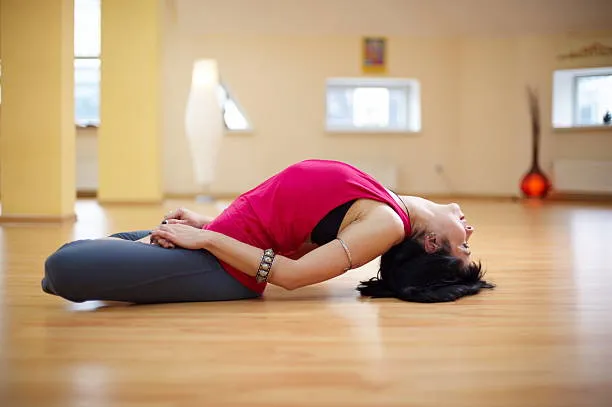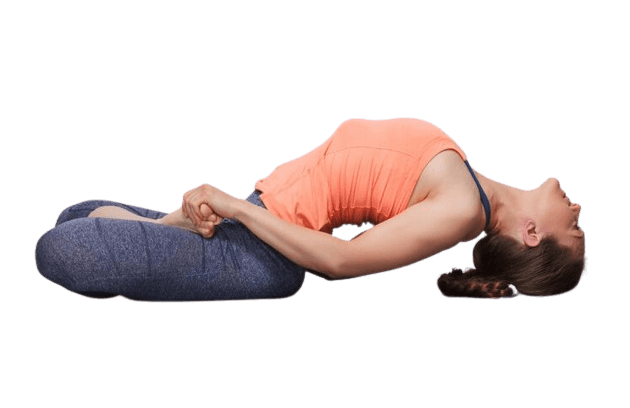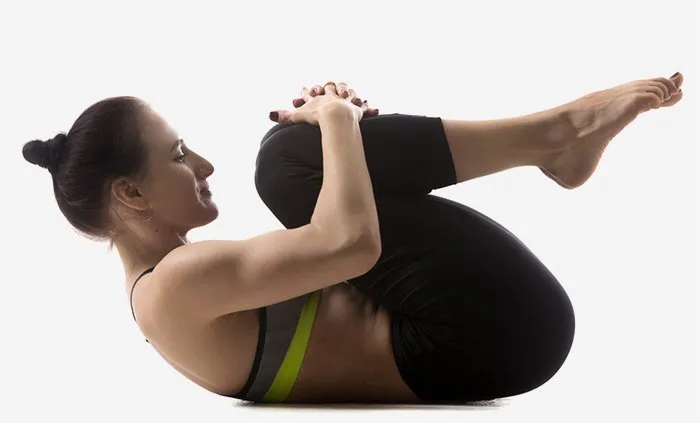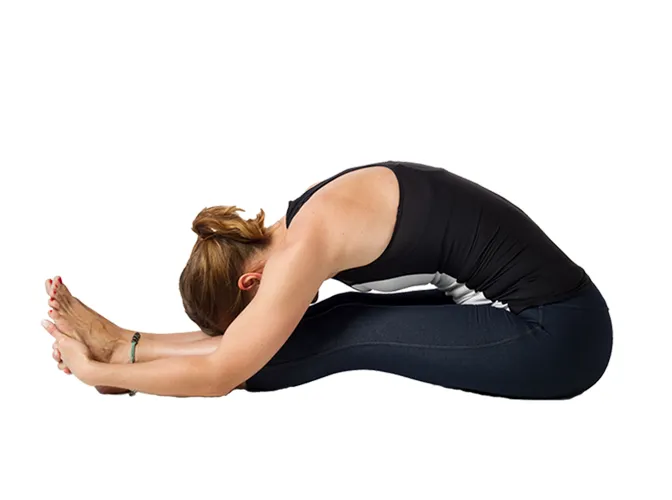On This Page
Matsyasana – Introduction, Procedure, and Benefits
Introduction
In Sanskrit the word Matsya means fish. Therefore, this Asana can be translated as the fish pose. At first this may seem a strange name for an Asan that seems to bear no resemblance whatsoever to any kind of fish.
इस आसन में शरीर की आकृति मछली: जैसी बनती है। क्योंकि इस आसन में मनुष्य मछली के समान बिना हिले-जुले बहुत समय तक तैरता रह सकता है। इसलिए इसे मत्स्यासन कहते हैं ।
Classical texts of Yoga
Matsyasana has been mentioned in various classical yoga texts. Brihan Naradiya Purana, a Puranic text compiled around 850 AD, Matsya Asana was first described and later it was mentioned in various Puranic texts like Hatha Yoga Pradipika (1400 AD), the foundational text of Hatha Yoga, Yoga Upanishads (1400 AD), Gherand Samhita and the Shri Tattva Nidhi.
Gheranda Samhita, Dwitiya Updesha, 21
मत्स्यासनम्
मुक्तपद्यासन॑ कृत्वा उत्तानशयनञ्चचरेत् ।
कूर्पराभ्यां शिरो वेष्य मत्स्यासनन्तु रोगहा।।
मत्स्यासन विधि– मुक्तपद्यासन लगाकर घुटनों में सिर का वेष्टन करके सीधे होकर (चित्तहोकर) शयन करें, इस प्रकार यह मत्स्यासन सब रोगों का नाशक होता है |
Procedure:
Three stages in procedure of Matasya Asana
Stage 1: Starting position
- Sit in Padmasana.
- If you cannot sit in Padmasana please don’t try to force your legs. Relax the whole body.
Stage 2: Leaning backward
- Lean slightly backward.
- Slightly behind and to the side of the buttocks place the hands on the floor. The straight arms support the weight of the body.
- Bend one of the arms, allowing the forearm and elbow to rest on the ground; to do this you will have to twist your body to one side.
- Then slowly bend the other arm so that both elbows are resting on the ground.
- At this stage above the ground behind the buttocks, the trunk and head should be supported. Then take the final position.
Stage 3: Final position
- Bend your head backward so that you can see the floor behind your head.
- Stretch the front of the neck as much as is comfortable.
- Slowly slide your arms forwards away from your head and lower the top of the head towards the ground. Gently support the body weight by the top of the head.
विधि
भूमि पर आसन बिछाकर पद्मासन की स्थिति में बैठें। फिर हथेलियों को थोड़ पीछे कर कोहनी को मोड़कर उस पर शरीर का भार देते हुए धीरे- धीरे पीठ के बल लेट जाएं। सिर को नीचे की ओर झुकाते हुए भूमि से लगाएं, जिससे चेहरा पीछे की ओर व छाती ऊपर की ओर उठी रहे। पद्यासन लगा रहे घुटने भूमि के साथ छुएं, हाथों से पांव के पंजे पकड़ कर कोहनियां भूमि से छुएं। श्वास भरते हुए पीठ नीचे सें पुल की तरह बननीं चाहिए। फिर गर्दन को सीधा करें, पद्मासन॑ को खोलें, शरीर ढीला करके विश्राम करें। स्वाभाविक श्वास की गति ठीक होने पर गहरां श्वास ले। ध्यान का केन्द्र विशुद्धि चक्र है।

Have A Health Issue?
Consult Online
- Dr. Sahil Gupta (B.A.M.S., M.H.A.)
Ayurvedic Allergy Specialist
CEO & Founder of IAFA®
Benefits
- Matsyasana gives an excellent massage of the abdominal organs, thereby helping to alleviate various types of digestive disorders.
- The ribcage and lungs are given an accentuated stretch which helps to improve the breathing process by allowing the chest to expand to full capacity during respiration. It is therefore a good Asana for those people who suffer from Shvasa Vaha Sansthana Roga i.e.,
- Shvasa Roga (asthma), bronchitis, or any other lung ailments.
- Matsyasana loosens up the whole spine and removes any tendency towards round shoulders. The associated nerve connections and blood supply are rendered more efficient.
- The nerves in the neck and the thyroid gland are particularly influenced.
- The pelvic region is also given a good stretch; this Asana is therefore useful for ladies in preventing or removing various forms of sexual malfunctions.
- The pressure of the legs on the thighs greatly reduces the blood circulation in the legs, the femoral arteries are compressed.
- The blood flow is diverted to the pelvic organs including the sexual glands (testes and prostate in males and ovaries in females), which helps to revitalize these organs and eliminate various types of associated ailments.
- It is also a useful Asana for loosening up the legs in preparation for sitting in still postures for meditation practice.
लाभ:
- इस आसन से मुख पर तेज आता है । मेरूदण्ड –लचीला तथा शक्तिवान बनता है।
- पाचक अंग में सुधार आता है, अजीर्ण, विवन्ध दूर होते हैं।
- कास, श्वास के रोगों में लाभ मिलता है। फुफ्फुस पुष्ट होते हैं।
- इस आसन को सवज्जि आसन के पश्चात करना चाहिए क्योंकि सर्वांग
- आसन में गर्दन आगे की ओर होती है तथा मत्स्यासन में पीछे की ओर झुकाई जाती है।
Counter and preparatory poses of Matsaya Asana
- Dhanurasana
- Shalabha Asana
- Baddha Kona Asana
- Bhujangasana
- Vira Asana
- Setu Bnadha Sarvanga Asana
- Supta Vira Asana
Follow up poses of Matasya Asana
- Supta Vira Asana
- Gomukha Asana
- Ushtra Asana
- Setu Bandha Sarvanga Asana
Contraindication
- People suffering from hypertension (high blood pressure) and hypotension (low blood pressure) will avoid this, Asana.
- People suffering from migraine and insomnia will avoid this Matsya Asana.
- Avoid this pose if you are suffering from a neck injury and lower backache.
- Avoid performing Matsya Asana if you are suffering from severe arthritis.
Modification and props use in Matsya Asana
For new beginners, Matsya Asana may be a little difficult to perform. In such situations the back can be supported by the thickly rolled blanket. But be sure that your Shira (head) will rest comfortably.
Precaution while performing Matsya Asana
- Avoid bending your neck backward with a jerk.
- When the head is ready to bear the weight, only then the supports of the hand should be removed.
- Never remove the support of the elbow to the neck.
- Avoid speedy and jerky movements when releasing the positions of Asana.








